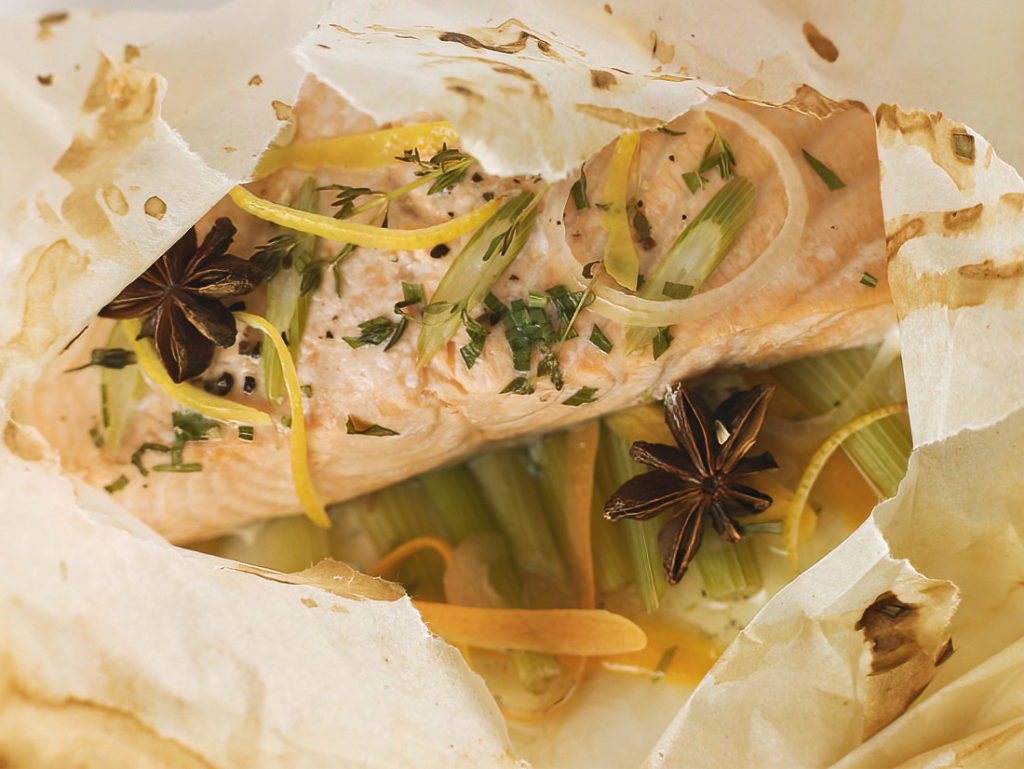Salmon en papillote is a traditional French dish in which the salmon is wrapped in parchment paper, trapping the flavors of herbs and aromatics while gently steaming in the oven. This method ensures the fish remains moist and full of flavor. Including fresh herbs, citrus zest, and optional star anise elevates the dish with subtle, aromatic notes. It is perfect for an elegant dinner or a quick, healthy meal.
Preparation Time
Prep Time: 15 minutes
Cook Time: 25 minutes
Total Time: 40 minutes
Ingredients (For Four People)
- 2 salmon fillets (approximately 200 g [7 oz] each)
- 1 leek, thinly sliced
- 2 cloves garlic, minced
- 1 lemon, zest, and thin slices
- 1 tablespoon olive oil
- 1 tablespoon white wine (optional)
- 1 teaspoon fresh thyme leaves
- 1 teaspoon fresh parsley, chopped
- Salt and black pepper, to taste
- 2 star anise pods (optional for added aroma)
- 2 parchment paper sheets (about 30 cm [12 in] square)
1 tablespoon is circa 15 ml, and a teaspoon is circa 5 ml.
Preparation Method
Step 1: Prepare the Parchment Paper
- Preheat your oven to 190°C (375°F).
- Cut two pieces of parchment paper, about 30 cm (12 in) square, to wrap each salmon fillet.
- Fold each sheet in half, open it up and place the fillet on one side of the fold.
Step 2: Season the Salmon
- Drizzle each salmon fillet with olive oil and sprinkle with minced garlic, fresh thyme, and parsley.
- Top the salmon with thin slices of lemon and a few leek strips.
- Season with salt and pepper to taste.
Step 3: Add Aromatics
- Add a dash of white wine for extra flavor, if using.
- Place a star anise pod beside the salmon fillets to infuse the dish with a subtle anise aroma.
Step 4: Fold and Seal the Parchment
- Fold the parchment paper over the salmon fillets, then crimp and fold the edges to form a sealed packet.
- Ensure the edges are tightly folded to prevent steam from escaping while cooking.
Step 5: Bake the Salmon
- Place the parchment packets on a baking sheet and bake in the oven for 12-15 minutes or until the salmon is tender and fully cooked.
- The parchment will puff up as it traps the steam, ensuring the salmon cooks gently.
Step 6: Serve
- Carefully open the packets at the table to release the fragrant steam.
- Serve the salmon with additional fresh herbs and steamed vegetables or rice.

Tips and Tricks
- Additional Flavor: For a different aromatic profile, you can add other herbs such as dill, basil, or even thinly sliced fennel.
- Parchment Paper Substitute: If you don’t have parchment paper, you can use aluminum foil, though parchment is preferred for a more authentic presentation.
Serving Suggestions
Serve Salmon en Papillote with a side of buttery baby potatoes, steamed asparagus, or a light green salad. The delicate flavors pair wonderfully with a crisp white wine, such as a Sauvignon Blanc or a Bulgarian Misket.
Wine Matching
For an ideal pairing, serve this dish with a crisp and mineral white wine like a Chablis or Sancerre. In Bulgaria, a Tamyanka would be a lovely local choice, offering floral notes that complement the delicate flavors of the dish.
Storage Suggestions
- Refrigeration: Store any leftovers in an airtight container in the fridge for up to 2 days.
- Reheating: Reheat gently in the oven, wrapped in foil, to avoid drying out the fish.
- Freezing: This dish is best served fresh, but you can freeze the uncooked salmon packets and bake them straight from the freezer, adding a few extra minutes of cooking time.
Nutritional Information
- Calories: 320 kcal per serving
- Protein: 34g
- Fat: 16g
- Carbohydrates: 6g
- Omega-3 Fatty Acids: High
Dietary Modifications
- Gluten-Free: This recipe is naturally gluten-free. Just ensure that any optional white wine used is gluten-free.
- Dairy-Free: This dish is dairy-free as written. For added richness, you can drizzle with olive oil before serving.
About Salmon en Papillote
“En papillote” is a classic French technique that wraps food in parchment paper before baking. The steam inside the sealed packet cooks the ingredients gently while preserving moisture and concentrating the flavors. This technique is particularly suited to delicate fish like salmon. Traditionally, it’s served directly in the paper, making it a beautiful presentation at the table.
Cultural Context
Salmon en papillote has its roots in French haute cuisine and is often associated with elegance and simplicity. Over time, this cooking method has become popular worldwide due to its healthy preparation and flavorful results. French chef Georges Auguste Escoffier is often credited with popularizing the technique. Today, it’s a versatile method used with various proteins and vegetables.


